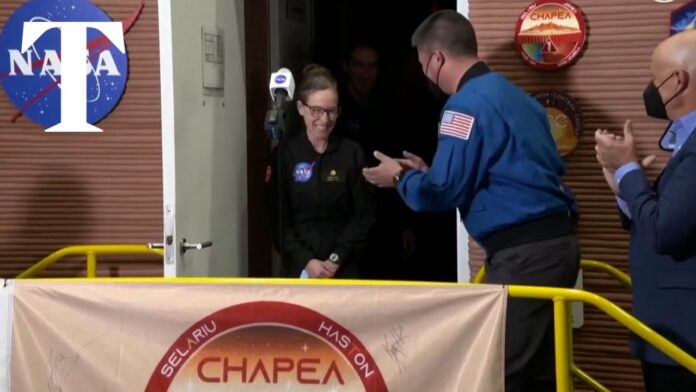After 378 days in isolation, NASA’s Mission 1 crew exits a simulated Mars habitat at the Johnson Space Center, marking the completion of a pioneering mission
In a milestone for space exploration, NASA‘s ambitious year-long Mars simulation culminated with the return of four dedicated volunteers to Earth. Kelly Haston, Anca Selariu, Ross Brockwell, and Nathan Jones emerged from their 1700-square-foot habitat at the Johnson Space Center in Houston on Saturday evening, greeted by a team of researchers and media.
Since June 25 of the previous year, these volunteers immersed themselves in a meticulously crafted simulation designed to replicate the conditions of a Mars mission. Their daily routines involved simulated Mars walks, cultivation of vegetables in a controlled environment, and scientific experiments crucial for sustaining life in a harsh, alien landscape.
The habitat, a 3D-printed structure, served not only as their living quarters but also as a testing ground for technologies and psychological resilience necessary for future deep-space missions. Among the challenges faced were simulated communication delays with Earth, mirroring the real-time constraints anticipated during missions to Mars.
The volunteers’ experiences were not just scientific endeavours but also profound tests of human endurance and adaptability. Each participant brought unique skills and perspectives, contributing to a comprehensive understanding of the physical and psychological impacts of long-duration space missions.
Analysis:
Political: NASA’s year-long Mars simulation underscores the agency’s commitment to advancing human space exploration. Such simulations receive bipartisan support as they demonstrate technological prowess and potential for international collaboration in space missions. Politically, successful simulations like this bolster NASA’s funding and public approval for future ambitious projects.
Social: Socially, the Mars simulation captivates public imagination and fosters enthusiasm for space exploration. It inspires the next generation of scientists and engineers, promoting STEM education and careers. Moreover, it highlights the challenges and triumphs of human resilience in extreme environments, offering valuable insights into human behaviour and teamwork under pressure.
Economic: Economically, NASA’s simulations drive innovation across various industries, from aerospace to robotics and life support systems. Investments in space exploration stimulate technological advancements that benefit both government agencies and private sector partners. Additionally, successful simulations pave the way for potential commercial ventures in space tourism and resource utilization, creating new economic opportunities.
